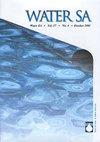Calibration, validation and application of the SWAT model to determine the hydrological benefit of wetland rehabilitation in KwaZulu-Natal, South Africa
IF 1.2
4区 环境科学与生态学
Q4 WATER RESOURCES
引用次数: 0
Abstract
In South Africa, with highly variable and intense land-use practices, coupled with limited soil fertility and water resources, there has been a long history of encroachment of arable lands (sugarcane and timber plantations) into surrounding wetlands. Although wetland delineation within the timber and sugar sectors is well-defined in policy, and existing and proposed legislation, there are significant areas of non-compliance. The spatially-explicit Soil Water Assessment Tool (SWAT) was adopted to investigate the interactions of climate, land-use and soil on the water-use of natural and encroached wetlands. This paper documents the calibration, validation and application of the SWAT model on Quaternary Catchment (QC) U20G, which is a 498 km2 catchment that forms part of the uMngeni River basin. The SWAT-CUP parameter sensitivity and optimization model was tested with daily observed streamflow data for this catchment. Parameters were modified using the sequential uncertainty fitting (SUFI-2) analysis routine to calibrate the model. The simulated flow had a close fit to the observed flow with a regression coefficient (r2) of 0.87 and a Nash-Sutcliffe (NS) coefficient of 0.8. Through the buffer scenario analysis, the model showed that if the wetland and a 20-m buffer were to be returned to a natural state, there could be a 16% increase in the annual streamflow contribution, with an upper limit of a 60% increase in some hydrologic response units (HRUs). Thus there would be a hydrological gain if wetlands and sensitive buffer areas were to be cleared of commercial timber species and sugarcane.SWAT模型在南非夸祖鲁-纳塔尔省湿地恢复水文效益确定中的校准、验证和应用
在南非,由于土地使用方式高度多变和密集,加上土壤肥力和水资源有限,可耕地(甘蔗和木材种植园)侵入周围湿地的历史由来已久。虽然在木材和制糖行业内的湿地划定在政策、现有和拟议的立法中都有明确的规定,但仍有许多不符合规定的领域。采用空间显式土壤水分评价工具(SWAT)研究了气候、土地利用和土壤对自然湿地和被侵占湿地水分利用的相互作用。本文对U20G第四系流域(QC)进行了SWAT模型的定标、验证和应用。U20G是uMngeni河流域的一部分,面积为498 km2。SWAT-CUP参数敏感性和优化模型利用该流域的每日观测流量数据进行了测试。采用序贯不确定性拟合(SUFI-2)分析程序修改参数,对模型进行校正。模拟流场与观测流场拟合较好,回归系数(r2)为0.87,Nash-Sutcliffe (NS)系数为0.8。通过缓冲区情景分析,该模型表明,如果湿地和20 m缓冲区恢复到自然状态,年流量贡献可增加16%,某些水文响应单位(hru)最多可增加60%。因此,如果清除湿地和敏感的缓冲地带的商业木材品种和甘蔗,将会在水文方面有所收获。
本文章由计算机程序翻译,如有差异,请以英文原文为准。
求助全文
约1分钟内获得全文
求助全文
来源期刊

Water SA
环境科学-水资源
CiteScore
2.80
自引率
6.70%
发文量
46
审稿时长
18-36 weeks
期刊介绍:
WaterSA publishes refereed, original work in all branches of water science, technology and engineering. This includes water resources development; the hydrological cycle; surface hydrology; geohydrology and hydrometeorology; limnology; salinisation; treatment and management of municipal and industrial water and wastewater; treatment and disposal of sewage sludge; environmental pollution control; water quality and treatment; aquaculture in terms of its impact on the water resource; agricultural water science; etc.
Water SA is the WRC’s accredited scientific journal which contains original research articles and review articles on all aspects of water science, technology, engineering and policy. Water SA has been in publication since 1975 and includes articles from both local and international authors. The journal is issued quarterly (4 editions per year).
 求助内容:
求助内容: 应助结果提醒方式:
应助结果提醒方式:


